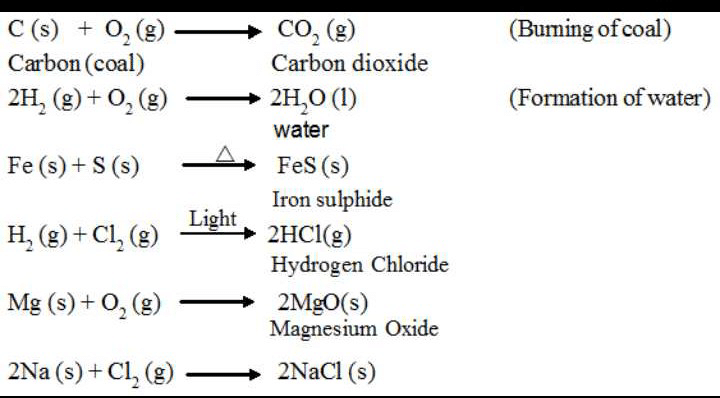Class 10 Exam > Class 10 Questions > Give 5 examples of combination reaction.?
Start Learning for Free
Give 5 examples of combination reaction.?
Most Upvoted Answer
Give 5 examples of combination reaction.?

Community Answer
Give 5 examples of combination reaction.?
Examples of Combination Reactions:
Explanation:
Combination reactions, also known as synthesis reactions, are chemical reactions in which two or more substances combine to form a single product. In these reactions, the reactants are usually elements or compounds, and the product is always a compound.
1. 2H2 + O2 → 2H2O: This is the chemical equation for the combustion of hydrogen gas. Hydrogen gas and oxygen gas combine to form water vapor when ignited. This reaction is exothermic and releases a significant amount of heat energy.
2. N2 + 3H2 → 2NH3: This is the chemical equation for the synthesis of ammonia gas. Nitrogen gas and hydrogen gas react under high pressure and temperature, with the aid of a catalyst, to form ammonia gas. Ammonia is widely used as a fertilizer and in the production of other chemicals.
3. CaO + H2O → Ca(OH)2: This is the chemical equation for the reaction between calcium oxide and water to form calcium hydroxide, also known as slaked lime. This reaction is highly exothermic and is often used in construction and agriculture.
4. Fe + S → FeS: This is the chemical equation for the formation of iron sulfide. Iron and sulfur react to form a compound with a characteristic odor of rotten eggs. Iron sulfide is commonly found in nature and is used to produce sulfuric acid.
5. 4Na + O2 → 2Na2O: This is the chemical equation for the reaction between sodium metal and oxygen gas to form sodium oxide. This reaction is highly exothermic and releases a significant amount of heat. Sodium oxide is used as a flux in the production of glass and ceramics.
- 2H2 + O2 → 2H2O
- N2 + 3H2 → 2NH3
- CaO + H2O → Ca(OH)2
- Fe + S → FeS
- 4Na + O2 → 2Na2O
Explanation:
Combination reactions, also known as synthesis reactions, are chemical reactions in which two or more substances combine to form a single product. In these reactions, the reactants are usually elements or compounds, and the product is always a compound.
1. 2H2 + O2 → 2H2O: This is the chemical equation for the combustion of hydrogen gas. Hydrogen gas and oxygen gas combine to form water vapor when ignited. This reaction is exothermic and releases a significant amount of heat energy.
2. N2 + 3H2 → 2NH3: This is the chemical equation for the synthesis of ammonia gas. Nitrogen gas and hydrogen gas react under high pressure and temperature, with the aid of a catalyst, to form ammonia gas. Ammonia is widely used as a fertilizer and in the production of other chemicals.
3. CaO + H2O → Ca(OH)2: This is the chemical equation for the reaction between calcium oxide and water to form calcium hydroxide, also known as slaked lime. This reaction is highly exothermic and is often used in construction and agriculture.
4. Fe + S → FeS: This is the chemical equation for the formation of iron sulfide. Iron and sulfur react to form a compound with a characteristic odor of rotten eggs. Iron sulfide is commonly found in nature and is used to produce sulfuric acid.
5. 4Na + O2 → 2Na2O: This is the chemical equation for the reaction between sodium metal and oxygen gas to form sodium oxide. This reaction is highly exothermic and releases a significant amount of heat. Sodium oxide is used as a flux in the production of glass and ceramics.
Attention Class 10 Students!
To make sure you are not studying endlessly, EduRev has designed Class 10 study material, with Structured Courses, Videos, & Test Series. Plus get personalized analysis, doubt solving and improvement plans to achieve a great score in Class 10.

|
Explore Courses for Class 10 exam
|

|
Similar Class 10 Doubts
Give 5 examples of combination reaction.?
Question Description
Give 5 examples of combination reaction.? for Class 10 2024 is part of Class 10 preparation. The Question and answers have been prepared according to the Class 10 exam syllabus. Information about Give 5 examples of combination reaction.? covers all topics & solutions for Class 10 2024 Exam. Find important definitions, questions, meanings, examples, exercises and tests below for Give 5 examples of combination reaction.?.
Give 5 examples of combination reaction.? for Class 10 2024 is part of Class 10 preparation. The Question and answers have been prepared according to the Class 10 exam syllabus. Information about Give 5 examples of combination reaction.? covers all topics & solutions for Class 10 2024 Exam. Find important definitions, questions, meanings, examples, exercises and tests below for Give 5 examples of combination reaction.?.
Solutions for Give 5 examples of combination reaction.? in English & in Hindi are available as part of our courses for Class 10.
Download more important topics, notes, lectures and mock test series for Class 10 Exam by signing up for free.
Here you can find the meaning of Give 5 examples of combination reaction.? defined & explained in the simplest way possible. Besides giving the explanation of
Give 5 examples of combination reaction.?, a detailed solution for Give 5 examples of combination reaction.? has been provided alongside types of Give 5 examples of combination reaction.? theory, EduRev gives you an
ample number of questions to practice Give 5 examples of combination reaction.? tests, examples and also practice Class 10 tests.

|
Explore Courses for Class 10 exam
|

|
Suggested Free Tests
Signup for Free!
Signup to see your scores go up within 7 days! Learn & Practice with 1000+ FREE Notes, Videos & Tests.

























